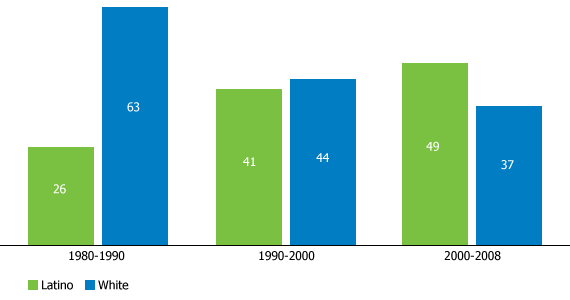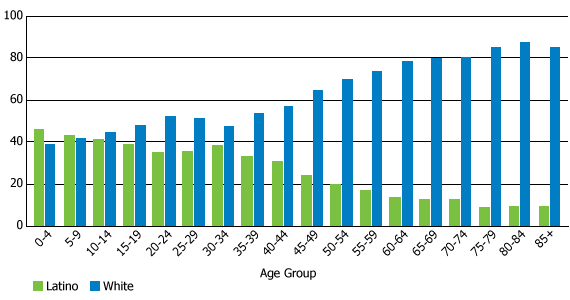
Latinos, Whites, and the Shifting Demography of Arizona
Date
August 11, 2010
Author
(September 2010) Over the past several decades, Latinos have made up an increasing share of the U.S. population. States along the U.S.-Mexico border are at the forefront of this transformation and their policy responses have generated great debate over the issue of immigration and border security. The signing of the legislative bill SB1070 in Arizona in April 2010 is the latest effort to try to round up undocumented immigrants and to stem their entry.1
What are some of the key demographic, political, and economic factors contributing to Arizona’s growing immigrant population and shifting racial/ethnic composition?
Rising Latino Immigration
Although the majority of Latinos in Arizona were born in the United States, the share of the foreign-born population increased from 18 percent in 1980 to 33 percent in 2008.2
A variety of factors have contributed to the state’s growing foreign-born population. The North American Free Trade Agreement (NAFTA) in 1994 stimulated immigration to the United States as many farmers in rural areas of Mexico could not compete effectively with U.S. agriculture.
In addition, beginning in the early to mid-1990s, the Immigration and Naturalization Service set up blockades in California and Texas to avert the entry of immigrants, resulting in more immigrants entering through Arizona.3 More than half of foreign-born Latinos living in Arizona in 2008 have entered the United States since 1994.
California’s weakening economy has also pushed many Latino immigrants to other states. While California’s share of all foreign-born Latinos in the four border states (Arizona, California, New Mexico, and Texas) dropped from 71 percent in 1980 to 60 percent in 2008, Arizona’s share rose from 3 percent to 7 percent over the same period.
The Shifting Demography of Arizona
The population of Arizona more than doubled from 2.7 million in 1980 to 6.5 million in 2008, growing from the 29th-largest state to the 14th-largest in the United States. Latinos accounted for two-fifths of the nearly 3.8 million people added to the state’s population between 1980 and 2008, as the Latino population more than quadrupled from nearly 441,000 in 1980 to almost 2 million in 2008.
The share of Arizona’s growth due to Latinos has grown significantly across the last three decades while the growth due to whites has declined (see Figure 1). One in every two people added to the state’s population between 2000 and 2008 was Latino. The percentage of Arizonans who are Latino increased from 16 percent in 1980 to 30 percent in 2008. In contrast, the share of the state’s population that is white declined from 75 percent in 1980 to 58 percent in 2008.
Figure 1
Percentage of Arizona Population Change Due to Latino and White Population Growth

Sources: Frank Hobbs and Nicole Stoops, Demographic Trends in the 20th Century; and U.S. Census Bureau, 2008 American Community Survey 1-Year Estimates.
Youthful Latinos and Aging Whites
The shifting racial/ethnic composition in Arizona reflects a major demographic divide between Latinos and whites across Arizona’s age spectrum. Whites account for over half of the state’s population ages 35 and older and make up at least 80 percent of those in elderly age categories (see Figure 2). In contrast, Latinos outnumber whites in the two youngest age groups (0 to 4 and 5 to 9). While the median age of the white population is 43, it is only 26 among Latinos.4
A younger age structure creates population momentum for Latinos through a high number of births relative to deaths. In 2006, while there were 1.2 births to every death among whites, there were 8.9 births to every death among Latinos, reflecting the youthfulness of the Latino population.5
Figure 2
Percentage of Latinos and Whites in Arizona Across Age Categories, 2008

Source: 2008 1% American Community Survey (ACS).
Implications
The shifting racial and ethnic composition of the Arizona population has led to the creation of practices and policies, such as SB1070, and the patrolling of its border by vigilante groups.6 Charges have been leveled that Latino immigrants are taking jobs from Americans and that they are not integrating into the American mainstream.
Others, however, argue that Latino immigrants take low-paying and dangerous jobs that many American shun. They also are concerned about the potential for racial profiling and the violation of human rights associated with laws such as SB1070.
The growth of the Latino population in Arizona has not occurred in a vacuum. The families of many Latinos in the state have been there for generations. Furthermore, globalization, the expansion of economies across international borders, and the aging of the populations of developed countries all stimulate the movement of people into places such as Arizona.
Rogelio Saenz is professor of sociology at Texas A&M University. The author acknowledges the helpful comments and suggestions of Eric Zuehlke.
References
- For details on SB1070, see Arizona State Legislature, “SB1070,” accessed at www.azleg.gov/DocumentsForBill.asp?Bill_Number=sb1070, on July 21, 2010.
- The data used in this report come from the following sources: Frank Hobbs and Nicole Stoops, Demographic Trends in the 20th Century, Census 2000 Special Reports, Series CENSR-4 (Washington, DC: U.S. Census Bureau, 2002); and the 1980 5% Public Use Microdata Sample (PUMS), 1990 5% PUMS, 2000 5% PUMS, and 2008 ACS Sample, downloaded from Steven Ruggles et al., Integrated Public Use Microdata Series: Version 5.0 (Minneapolis: University of Minnesota, 2010), accessed at http://usa.ipums.org/usa/index.shtml, on July 21, 2010.
- Karl Eschbach et al., “Death at the Border,” International Migration Review 33, no. 4 (1999): 430-40.
- U.S. Census Bureau, 2008 American Community Survey 1-Year Estimates, accessed at http://factfinder.census.gov/servlet/DatasetMainPageServlet?_program=ACS&_submenuId=&_lang=en&_ts=, on July 21, 2010.
- Joyce A. Martin et al., “Births: Final Data for 2006,” National Vital Statistics Reports 57, no. 7 (Hyattsville, MD: National Center for Health Statistics, 2009); Compressed Mortality File Underlying Cause of Death: Mortality for 1999-2006 With ICD 10 Codes (Atlanta: Centers for Disease Control and Prevention), accessed at http://wonder.cdc.gov/mortSQL.html, on July 21, 2010. See also: Carl Haub, “Hispanics Account for Almost One-Half of U.S. Population Growth,” accessed at www.prb.org/Publications/Articles/2006/HispanicsAccountforalmostOneHalfofUSPopulationGrowth.aspx, on July 21, 2010.
- The Associated Press, “Militia With Neo-Nazi Ties Patrols Arizona Desert,” The New York Times, July 18, 2010, accessed at www.nytimes.com/2010/07/18/us/18militia.html, on July 21, 2010.
